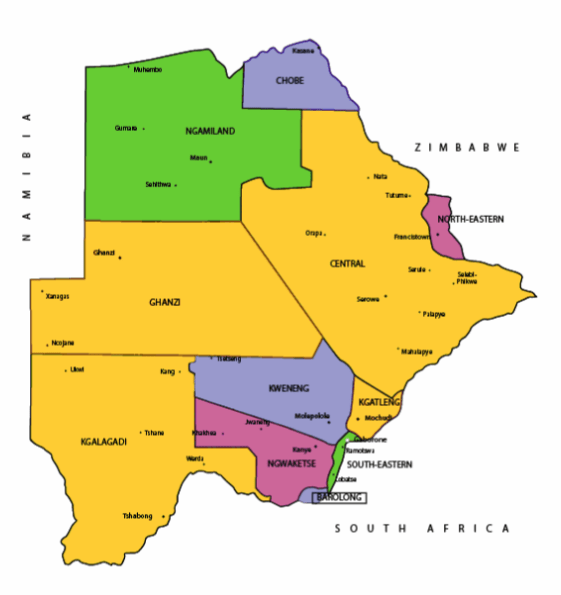Places and their polling stations in Lobatse, Botswana
378 Boswelatlou
1768 Lobatse SSS
1769 Lobatse Brigade Centre
1770 Tent At Burs Offices
1771 Crescent School
379 Tsopeng North
1772 Pitikwe JSS
1773 Open Space Lot 3791 (Tent)
1774 Catholic Church
380 Tsopeng South
1775 Letsopa JSS
1776 Boithaopo Day Care Centre
1777 Shha Ii Office
381 Botoka
1778 Old Woodhall Kgotla
1779 Open Space Lot 2738 (Tent)
1780 Open Space (Tent Near Sebonego)
382 Thema-Motswedi
1781 Ipelegeng JSS
1782 Lesedilapela School
383 Peleng East
1783 VDC House
1784 Kgodiso Day Care Centre
1785 Pentecostal Protestant Church
384 Peleng Central
1786 New Peleng Kgotla
1787 Hill Primary School
385 Peleng West
1788 Peleng West Primary School
1789 Hillside (Tent)
1790 Peleng West Old Kgotla
386 Maokaneng
1791 Anglican Church
1792 Lutheran Church
1793 Agriculture Research Offices
387 Newlook-Maipei
1794 Newlook Primary School
1795 Shha 1 Office Building
388 Woodhall
1796 Bothakga Primary School
1797 Bcw Nursery School
389 Lobatse Farms
1798 Doomlagte (Tent)
1799 Lobatse Estates Hq
1800 Lamet’s Place (Tent)
1801 Openshaw’s Farm
1802 Wuc Pump Station
Reference: iec.gov.bw/index.php/electoral-districts/polling-stations.html
Botswana
Botswana is a country in Africa. It is topographically flat, with approximately 70 percent of its territory being the Kalahari Desert.
It is bordered by South Africa to the south and southeast, Namibia to the west and north, and Zimbabwe to the northeast.
Capital: Gaborone
Currency: Botswanan Pula
Official language: English
Population: 2.588 million (2021) World Bank
Dialing code: +267
Gross Domestic Product: 17.61 billion USD (2021) World Bank
Botswana’s ten districts are:
- Southern District
- South-East District
- Kweneng District
- Kgatleng District
- Central District
- North-East District
- Ngamiland District
- Kgalagadi District
- Chobe District
- Ghanzi District
Botswana’s councils created from urban or town councils are: Gaborone City, Francistown, Lobatse Town, Selebi-Phikwe Town, Jwaneng Town, Orapa Town and Sowa Township.






The name Botswana refers to ‘Land of the Tswana’. The landlocked, Southern Africa country is officially known as the Republic of Botswana.














Botswana is connected to Zambia through the Kazungula Bridge making it the world’s shortest border between two countries.
A country of slightly over 2 million people (2021), Botswana is one of the most sparsely populated countries in the world. It is essentially the nation state of the Tswana ethnic group, who make up 79% of the population.

About 11.6 per cent of the population lives in the capital and largest city, Gaborone.
Formerly one of the world’s poorest countries—with a GDP per capita of about US$70 per year in the late 1960s—it has since transformed itself into an upper-middle-income country, with one of the world’s fastest-growing economies.


The Tswana ethnic group were descended mainly from Bantu-speaking tribes who migrated southward of Africa to modern Botswana, living in tribal enclaves as farmers and herders.




In 1885, the British colonised the area and declared a protectorate under the name of Bechuanaland.
As colonisation stopped, Bechuanaland became an independent republic under its current name on 30 September 1966.


Since then, it has been a representative republic, with a consistent record of uninterrupted democratic elections and the lowest perceived corruption ranking in Africa since at least 1998.

The economy is dominated by mining and tourism. Botswana has a GDP (purchasing power parity) per capita of about $18,113 as of 2021, one of the highest in subsaharan Africa.


Botswana is the world’s biggest diamond producing country.
Its relatively high gross national income per capita gives the country a high standard of living and the third-highest Human Development Index of continental Sub-Saharan Africa (after Gabon and South Africa).
The country has been adversely affected by the HIV/AIDS epidemic. In 2002, Botswana began offering anti-retroviral drugs (ARVs) to help combat the epidemic.
Botswana is a member of the Southern African Customs Union, the Southern African Development Community, the Commonwealth of Nations, and the United Nations.
